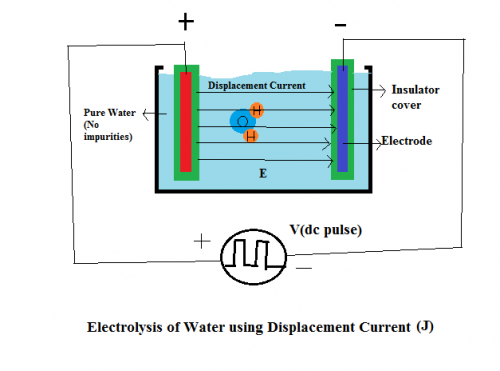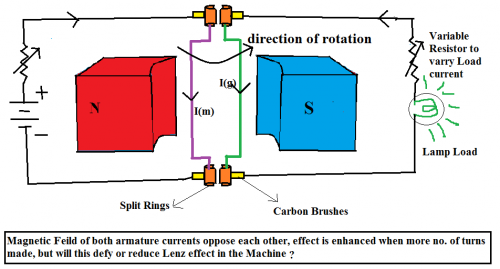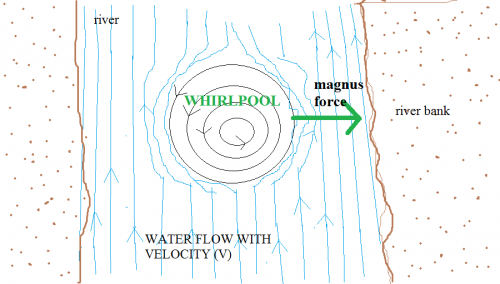-
Posts
11 -
Joined
-
Last visited
Content Type
Profiles
Forums
Events
Posts posted by Proud Teslian
-
-
what do you think is missing ? i have animated the idea for easier understanding ? if you tell me what's missing i'll explain it to you!
0 -
The Figure shows two insulated metal electrodes kept in pure water with a small gap between them.
When sufficiently large Voltage pulses applied between electrodes, there is a flow of displacement current through the insulators and water, but will this split the water molecules?
All your answers are welcomed !
0 -
That is one deep review @Primate thanks for your Explanation
0 -
I wondered if you envisaged more turns when you first posted and I can see the machine you are describing as a combined motor and generator with alternate turns connected to the motor and the generator.
This would work, but it is not in contravention of Lenz law, which I think you misunderstand.
Both the motor windings and the generator windings are subject to a generated emf, known as back emf.
However the back emf serves different purposes in the two sets of windings.
In the motor section the back emf serves to limit (reduce) the 'applied voltage' and thus the drive current. It does indeed opposes the driving emf directly.
In the generator section there is no driving emf or applied voltage. There is only mechanical driving of the shaft by the motor section.
The Faraday voltage generated obeys Lenz law and provides the emf to power the external load lamp.
This explanation from 'Nightingale' may help.
Exactly what happens will depend upon the relative circuit values; the driving battery voltage, the circuit resistances in the motor and dynamo circuits, the lamp load resistance.
However there are devices known as rotary converters which can convert (battery) DC to other values of DC or AC supply.
These are less common today with modern electronic alternatives, but are still used for very high powers.
Rotary converters work on essentially the same principles as we are discussing.
Nice Explanation @Genius i recheck my idea about where i was wrong
0 -
it is difficult to move rotor of generator (green) because the magnetic field of induced current is opposing the rotation (lenz law), but if that magnatic feild is cancelled by another adjecent rotor, then the question is will the generator rotor move freely in the field (the diagram shows only half a turn in each rotor, so please imagine more turns)
0 -
1. In the given figure, the two rotors (purple, green) are electrically isolated but mechanically fit to rotate along same axis2. The motor action on the left side rotor will move the armature set, this will produce currents in right side rotor that will pass via a variable load.3. do you see the magnetic feilds of both rotors cancelling each other especially when the no. of turns are large and the two rotors are close enough.4. Will this cancel lenz effect on generator side or both sides?0
-
i'm not intrested in what happens to whirlpools at rivers, but i was actually trying to relate it to an universal phenomeon, which i feel difficult to reveal directly.
some people will understand what i'm trying to relate it to.
0 -
Which do you want me to do?
"a big river with water flowing constant velocity"
or
"assume there is a whirlpool "
I can't do both because the rotating bit clearly hasn't got a constant velocity.
In order for there to be a whirlpool something must be causing it and there's definitely a reaction force against whatever that cause might be.
But unless you can tell us what the whole story is, there's no way we can get very far.
It is possible to produce whirlpool in constantly moving fluid
1. immerse an Egg beater vertically and run it
2. make a hole at bottom and suck out fluid fastly
off-course the water in whirlpool is not in constant velocity, but the rest of the river is.
0 -
ok forget the whirlpool, imagine a tornado, suppose a strong wind current flows towards it will it experience magnus force?
0 -
1. Imagine a big river with water flowing constant velocity , assume there is a whirlpool at center as shown in the figure.
2. Because of the magnus force the whirlpool should move towards left or right towards river bank depending on the spin, but it does't happens it just stays fine in its position....so why?
3. I belive that magnus force will exists in whirlpool only when the velocity of water changes (acceleration), not just velocity , since the whirlpool is itself a part of the water flow.
4. apply the same to faraday's law of electromagnetic induction as anology ( magnetic feild as river and charge as whirlpool ), is this correct?
0






Electrolysis using Displacement current ?
in Physics
Posted
OK ...To say simple above idea tries to achieve dielectric Breakdown of water using strong E field.
H2O has 65KV / mm strength, ......but heat and input frequency will lower the Breakdown voltage and make the idea engineerable.